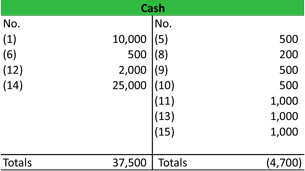
However, if a company has a ROA that is much higher than the average of its peer companies, for example, 20% compared to the average 15%, it could mean either of two scenarios. Advisory services provided by Carbon Collective Investment LLC (“Carbon Collective”), an SEC-registered investment adviser. Thanks to its flexibility, you can choose the method that will help you to see the most accurate ratio depending on the context. By using different numbers you might be misrepresenting your actual ROA.
A higher ROA means a company is more efficient and productive at managing its balance sheet to generate profits while a lower ROA indicates there is room for improvement. Return on assets (ROA) is a ratio used to calculate how profitable a business is in relation to its assets. ROA is one of a suite of financial ratios that helps an investor understand a company’s financial strength. In this article, we will explore how to calculate it, why it’s important, and how investors can use it to make more informed investment decisions.
What Does ROA Tell You?
The return on assets measures the profitability of a company in relation to its total assets. Efficiency is very key in business and a company’s profit can be compared to its revenue. The feasibility of the company’s existence can be determined why does gaap require accrual basis accounting by comparing the company’s profit to the resources used to earn these profits and revenue. Therefore, the return on assets interpretation gives a clearer picture of the earnings generated from a company’s invested assets and capital.
There’s Been No Shortage Of Growth Recently For Corteva’s (NYSE:CTVA) Returns On Capital – Simply Wall St
There’s Been No Shortage Of Growth Recently For Corteva’s (NYSE:CTVA) Returns On Capital.
Posted: Tue, 27 Jun 2023 14:58:03 GMT [source]
However, you shouldn’t compare to ROA of Facebook with, say, the ROA of McDonald’s because the two are in completely different industries. The data below is the ROA of each company from October through December 2018, and it comes from Macrotrends. The business world is full of acronyms, and keeping them all straight can be tough. You can use the return on assets calculator below to quickly calculate a company’s profitability in relation to its assets by entering the required numbers. Some companies can run mostly through capital and service-focused experiences.
Comparisons Over Time
The ROA figure gives investors an idea of how effective the company is in converting the money it invests into net income. The higher the ROA number, the better, because the company is able to earn more money with a smaller investment. Keep in mind when comparing return on assets that it varies by industry.
- Management and earnings capabilities are essential factors, as well as the method used by companies to finance their assets.
- Sometimes, they cannot even be used to compare businesses in the same industry, because each business operates and manages its assets differently.
- When demand is reduced, most companies will sell assets to recoup some money, but they will often hold some assets in reserve to reduce spending during the next upward swing in demand.
- For example, the company purchasing a large piece of equipment for $50,000, will warrant the company using its $20,000 in profit with an additional $30,000 gotten as a loan.
- After dividing the net profit by average assets, multiply the value by 100 to get the ROA percentage.
ROA can also be used to make apples-to-apples comparisons across companies in the same sector or industry. Your ROA percentage indicates how well your business manages its balance sheet to generate profits. And, looking at your ROA and comparing it to others can help you determine where you stand. Your return on assets, or ROA, indicates how profitable your business is by comparing net income with your total assets.
What Do You Have to Watch out for When You’re Performing Return On Assets?
It is a ratio that helps us to understand what the company is doing with the assets they have available to them. Take, for instance, a software company that has far fewer assets on the balance sheet. Comparing this firm with a car manufacturing company is futile because the software maker has lesser assets than the car maker. Therefore, the assets of the software company will be understated and its ROA may get a questionable boost.
What does a return on assets of 12.5% represent?
What does a return on assets of 12.5% represent? The company generates a profit of $12.5 for every $1 in sales. The company generates $1 in profit for every $12.5 in total assets.
The measure indicates whether management can effectively utilize assets to generate a reasonable return for a business, not including the effects of taxation or financing issues. However, a higher ROA than the industry average may not always be a good sign of efficiency. It could mean that the company isn’t investing enough in assets, which could cause problems in the future. Furthermore, a rising ROA tends to be a good sign, indicating that the company is increasing its profits with each dollar invested in the total assets of the company. A declining ROA, on the other hand, can be an indication that the company may have made poor capital investment decisions and is not deriving enough profit to justify the cost of purchasing those assets.
What’s the difference between ROA and return on equity?
When demand is reduced, most companies will sell assets to recoup some money, but they will often hold some assets in reserve to reduce spending during the next upward swing in demand. ROOA takes into account that all assets are not typically being used at any given time. Another standard measurement of assets and the returns they produce is known as the “return on operating assets” (ROOA). If ROA is calculated for companies in different industries, it will not be very meaningful since ROAs vary widely among industries and groups of companies within the same industry. If ROE is increasing over time it means that the company has been using a smaller percentage of its assets to produce income.
10 Key Financial Ratios Every Investor Should Know – Forbes
10 Key Financial Ratios Every Investor Should Know.
Posted: Thu, 08 Jun 2023 07:00:00 GMT [source]
It is also a measure of how much the company relies on assets to generate profit. Return on assets is calculated by dividing net income by total assets and the result of the calculation can tell how well a business is using its assets to generate net income. The return on assets equation is a ratio that can shine a light on how successful a company’s management is at development and growth. Because this formula looks at the total assets and not net assets, this isn’t a very popular formula for investors.
We are going to look at an example of how to find return on assets from the balance sheet. Using the Exxon Mobil Corporation (XOM) as an example, below is an excerpt of Exxon’s income statement and balance sheet from its 10K statement (pages 72 & 74) for 2020 and 2021. A company with a high ROA would likely have fewer assets involved in generating its profits. The return on assets ratios that are higher than 15% could be an indication that the company has made more profit for each dollar of assets it has employed. Therefore, it is crucial to compare a company’s ROA over multiple accounting periods.
What is the difference between ROE and ROA?
Return on equity (ROE) and return on assets (ROA) are two key measures to determine how efficient a company is at generating profits. The main differentiator between the two is that ROA takes into account leverage/debt, while ROE does not. ROE can be calculated by multiplying ROA by the equity multiplier.
